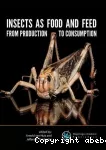Adresse
Infodoc : Réseau des bibliothèques et centres de documentation d'AgroParisTechFrance
contact
Array
(
[TITRE] => <b>Type de document : </b>
[TITRE_CLEAN] => Type de document
[OPAC_SHOW] => 1
[TYPE] => list
[AFF] => Livre
[ID] => 4
[NAME] => cp_typdoc
[DATATYPE] => integer
[VALUES] => Array
(
[0] => 5
)
)

| Titre : |
Insects as food and feed : from production to consumption
|
| Auteur(s) : |
Arnold Van Huis, Éditeur scientifique
Jeffery K. Tomberlin, Éditeur scientifique |
| Type de document : | Livre |
| Sujets : | INSECTE Acrididés ; Aliments -- Consommation ; Aliments -- Séchage ; Analyse des dangers et maîtrise des points critiques ; Animaux -- Alimentation ; Aspect nutritionnel ; Chitine ; Consommation ; Criquet pèlerin ; Élevage ; Entomophagie ; Environnement ; Industries agroalimentaires ; Insectes comestibles ; Lipides ; Maladies à virus chez les animaux ; Nutriments ; Production ; Produit alimentaire ; Protéines ; Réglementation ; Risques pour la santé ; Santé |
| Résumé : |
Alternative protein sources are urgently required as the available land area is not sufficient to satisfy the growing demand for meat. Insects have a high potential of becoming a new sector in the food and feed industry, mainly because of the many environmental benefits when compared to meat production. This will be outlined in the book, as well as the whole process from rearing to marketing. The rearing involves large scale and small scale production, facility design, the management of diseases, and how to assure that the insects will be of high quality (genetics). The nutrient content of insects will be discussed and how this is influenced by life stage, diet, the environment and processing. Technological processing requires decontamination, preservation, and ensuring microbial safe[...] Alternative protein sources are urgently required as the available land area is not sufficient to satisfy the growing demand for meat. Insects have a high potential of becoming a new sector in the food and feed industry, mainly because of the many environmental benefits when compared to meat production. This will be outlined in the book, as well as the whole process from rearing to marketing. The rearing involves large scale and small scale production, facility design, the management of diseases, and how to assure that the insects will be of high quality (genetics). The nutrient content of insects will be discussed and how this is influenced by life stage, diet, the environment and processing. Technological processing requires decontamination, preservation, and ensuring microbial safety. The prevention of health risks (e.g. allergies) will be discussed as well as labelling, certification and legislative frameworks. Additional issues are: insect welfare, the creation of an enabling environment, how to deal with consumers, gastronomy and marketing strategies. Examples of production systems will be given both from the tropics (palm weevils, grasshoppers, crickets) and from temperate zones (black soldier flies and house flies as feed and mealworms and crickets as food). |
| Editeur(s) : | Wageningen : Wageningen Academic Publishers |
| Date de publication : | 2017 |
| Format : | 1 vol. (447 p.) / ill. en coul., couv. ill. en coul. / 24 cm |
| Note(s) : |
Bibliogr. Annexes |
| Table des matières : |
Introduction
Introduction |
| Langue(s) : | Anglais |
| Identifiant : | 978-90-8686-296-2 |
| Lien vers la notice : | https://infodoc.agroparistech.fr/index.php?lvl=notice_display&id=192909 |
Exemplaires (2)
| Localisation | Emplacement | Pôle | Section | Cote | Support | Disponibilité |
|---|---|---|---|---|---|---|
| Palaiseau | Vert | TU Aliments - Cosmétiques - Biomatériaux | TU4.16 VAN | Papier | Indisponible : ouvrage non rendu Exclu du prêt | |
| Palaiseau | Vert | TU Aliments - Cosmétiques - Biomatériaux | TU4.16 VAN | Papier | Indisponible : ouvrage manquant Exclu du prêt |




